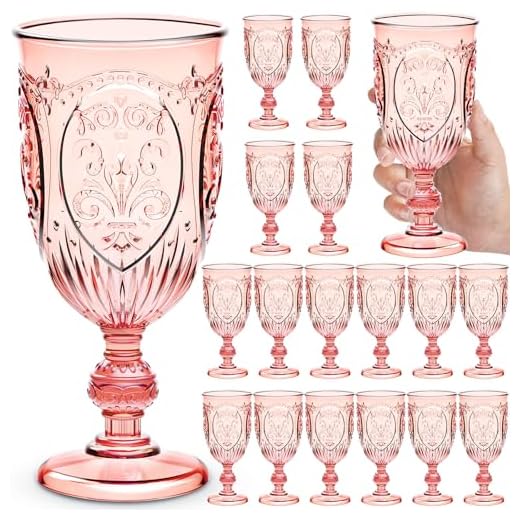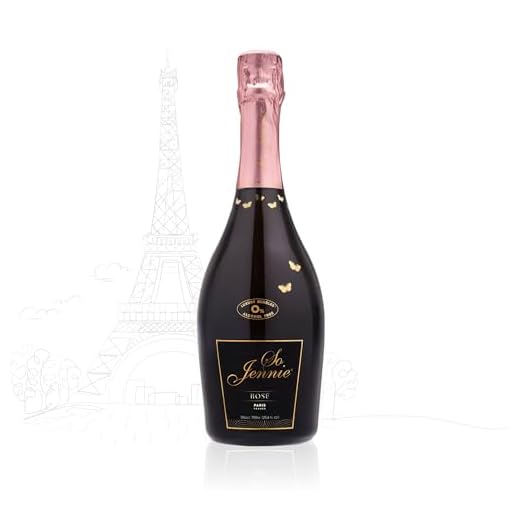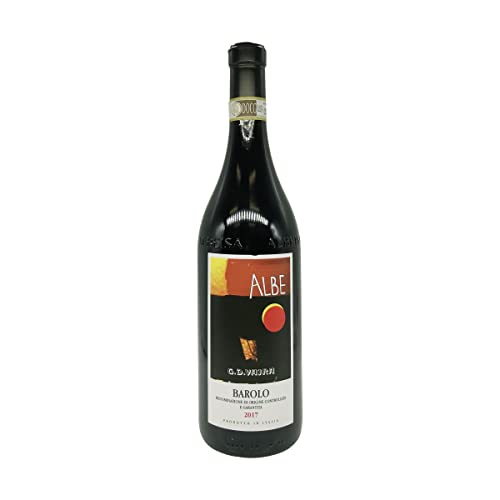



If you’re seeking an exquisite experience with a selection of pink beverages, I recommend exploring the 2021 Château d’Esclans Whispering Angel. This offering from Provence showcases delicate notes of strawberries and raspberries, complemented by a refreshing acidity that makes it perfect for warm-weather sipping. Pair it with grilled shrimp or a light salad for an ideal culinary match.
Another standout is the 2020 Domaine de la Vieille Julienne. This gem from the Southern Rhône offers a beautiful balance of fruit and mineral elements, making it a versatile choice for various dishes. Its aromatic profile includes hints of peach and citrus, providing a delightful contrast to rich foods like roasted chicken or creamy pasta.
For those on a budget, the 2021 Bodega Norton Brut Rosé is a fantastic option. Originating from Argentina, this sparkling variant not only boasts a lively effervescence but also features flavors of cherry and watermelon. It’s an excellent choice for celebrations or casual gatherings, pairing beautifully with charcuterie boards or spicy dishes.
When selecting your next bottle, consider the region and style that best suits your palate. Each option brings its unique character, allowing for a personalized tasting experience. Enjoy the exploration of flavors and aromas that these pink drinks offer, and remember that the right pairing can elevate your meals to new heights.
A Dozen Rosé Selections
For a delightful experience, I recommend exploring the 2021 Château d’Esclans Whispering Angel. This offering showcases a beautiful balance of fruit and acidity, making it an excellent companion for seafood dishes or light salads.
Another standout is the 2019 Domaine Tempier Bandol. Its complexity and depth make it perfect for pairing with grilled meats or Mediterranean cuisine. The notes of strawberry and herbs create a harmonious blend that excites the palate.
Consider the 2020 Miraval Rosé for a fresher, more modern option. This wine presents bright citrus and floral aromas, ideal for summer gatherings or picnics. It pairs wonderfully with charcuterie boards and light appetizers.
The 2018 Château de Pibarnon offers a richer profile, with hints of stone fruit and a lingering finish. This selection shines alongside roasted vegetables or creamy pasta dishes.
Don’t overlook the 2020 Côtes de Provence from Château Minuty. Its crispness and minerality make it an approachable choice for casual sipping or pairing with sushi and Asian cuisine.
For those who appreciate a slightly sweeter style, the 2019 Bodegas La Rosa Garnacha Rosado brings vibrant red fruit flavors and a refreshing finish. It complements spicy dishes and fruity desserts beautifully.
Lastly, the 2021 Elk Cove Pinot Noir Rosé presents a unique take, showcasing the elegance of Pinot Noir while remaining light and refreshing. This wine pairs well with grilled chicken or a variety of cheeses.
Understanding the Different Styles of Pink Wine
To appreciate pink beverages, it’s essential to recognize the various styles available. Each type offers a unique tasting experience influenced by grape varieties, production methods, and regional characteristics.
Styles of Pink Beverage
- Direct Pressing: This method involves pressing red grapes to extract juice while minimizing skin contact, resulting in a lighter hue and crisper profile. Ideal for those who prefer a refreshing sip.
- Saignée Method: Here, a portion of the juice is bled off from red wine fermentation. This technique enhances the concentration of the red wine, leading to richer flavors and a deeper color in the final product.
- Blending: Combining red and white varietals creates a unique concoction. While less common, this approach can produce intriguing results, showcasing elements from both styles.
Flavor Profiles
- Crisp and Fruity: Common in lighter styles, often featuring notes of strawberries, watermelon, and citrus.
- Rich and Complex: These are typically deeper in color, exhibiting flavors like raspberry, cherry, or peach, often with a fuller body.
- Herbal and Spicy: Some varieties may present herbal nuances or a hint of spice, providing an interesting contrast to the fruitiness.
Experimenting across these styles will enhance your understanding and appreciation of pink beverages. Pairing them with food can elevate the experience further, making it an enjoyable exploration of flavors and textures. I encourage you to explore these options and find your preferred style.
Best Regions for Producing Quality Rosé Wines
Provence, France, stands out as the premier location for crafting exceptional pink beverages. The warm Mediterranean climate, combined with a diverse array of terroirs, yields wines that are fresh and aromatic. The Côtes de Provence AOC is renowned for its delicate flavors and crisp acidity, making it a go-to for enthusiasts.
Another remarkable area is the Tuscany region in Italy. Known for its Sangiovese grapes, Tuscany produces pinks that showcase rich fruit notes alongside herbal undertones. The Chianti Classico and Montalcino zones are particularly notable for their exquisite offerings.
In the United States, California shines with regions like Sonoma and Paso Robles. These areas benefit from ample sunshine and varied microclimates, allowing winemakers to experiment with different varietals, producing vibrant and complex wines that appeal to a wide audience.
Spain also deserves recognition, especially the Navarra region. This area is celebrated for its Garnacha-based pinks that often feature a fuller body and richer flavors. The traditional methods blended with modern techniques create distinctive products that showcase the local terroir.
| Region | Key Characteristics |
|---|---|
| Provence, France | Fresh, aromatic, diverse terroirs |
| Tuscany, Italy | Rich fruit notes, herbal undertones |
| Sonoma, California | Vibrant, complex, experimental varietals |
| Navarra, Spain | Full-bodied, rich flavors from Garnacha |
Each of these regions offers unique expressions that reflect their environment and winemaking traditions. Exploring these areas will undoubtedly lead to delightful discoveries. For those interested in enhancing their culinary skills while enjoying a glass, check out this guide on how to cook a baked potato quickly for perfect pairings.
How to Properly Taste and Evaluate Pink Varietals
Begin with a visual assessment. Pour a small amount into a clear glass and observe the color. Look for shades ranging from pale salmon to deeper pink hues, indicating different grape varieties and styles. The clarity should be pristine, reflecting good winemaking practices.
Next, swirl the glass gently to release aromas. Bring the glass to your nose and take a deep inhale. Identify the fragrance components; you may detect notes of strawberries, raspberries, or floral hints. Assess the intensity of the aromas, as this can indicate the quality of the beverage.
Take a small sip and let it coat your palate. Pay attention to the acidity; a refreshing acidity balances fruitiness and enhances food pairing potential. Notice the body; it can range from light to medium, affecting the overall mouthfeel. Note any flavors that emerge, such as citrus, melon, or herbal undertones, and determine if they align with the aromas you previously identified.
Consider the finish. A long, pleasing aftertaste often signifies a higher quality product. Reflect on the overall balance between acidity, sweetness, and tannin levels. A well-structured pink drink should leave you wanting more, inviting a second sip.
Finally, take notes on your impressions. Documenting your tasting experiences will help you refine your palate and deepen your appreciation for this delightful beverage category. Remember, tasting is subjective, and your unique preferences will guide your future selections.
Food Pairings That Enhance the Experience of Pink Wine
Pairing seafood with a chilled bottle of this blush beverage is a seamless match. The light, refreshing notes complement the delicate flavors of dishes like grilled shrimp or seared scallops beautifully.
Recommended Pairings
- Grilled Salmon: The rich texture of salmon balances well with the acidity and fruitiness of the drink.
- Caprese Salad: Fresh mozzarella, tomatoes, and basil harmonize with the crispness and floral aromas.
- Spicy Asian Cuisine: Dishes like Thai curry or sushi work wonderfully, as the sweetness can offset the heat.
- Pork Tenderloin: The wine’s berry flavors enhance the savory notes of roasted pork.
- Charcuterie Board: A selection of cured meats, cheeses, and olives creates a delightful tasting experience.
Less Conventional Options
- Vegetable Tacos: The earthy flavors of grilled vegetables and spices are elevated by the drink’s acidity.
- Fruit Tart: A dessert pairing that showcases the sweet, fruity characteristics, making for a refreshing end to a meal.
- Feta and Watermelon Salad: This combination highlights the drink’s crispness and enhances the summer vibe.
Exploring these pairings will certainly enhance your appreciation for this delightful beverage, transforming each sip into a memorable experience. Enjoying this vivid drink with food is about balance and finding harmony in flavors. Cheers!
Tips for Storing and Serving Pink Beverage at Home
Maintain a consistent temperature between 45°F and 55°F for optimal preservation. A dedicated wine fridge is ideal, but a regular refrigerator can work if you allow the bottle to warm slightly before serving.
Store bottles upright to prevent cork damage and oxidation. If you have a corked variety, horizontal storage can help keep the cork moist, but be mindful of the bottle’s position.
Avoid exposure to light and vibrations. Keep your collection in a dark, quiet place, as UV rays can degrade the quality of your drink over time.
Serve chilled, ideally around 50°F. If you don’t have a thermometer, place the bottle in an ice bucket for about 20 minutes before pouring. This will enhance the refreshing qualities and aromas.
Use appropriate glassware. A tulip-shaped glass concentrates the scents and allows for better appreciation of the drink’s characteristics. Ensure the glass is clean and free from any residual scents.
Pour about one-third of the glass full to allow for proper aeration. This helps in releasing the bouquet and makes for a more enjoyable tasting experience.
For those planning to serve multiple bottles, consider using a wine preservation system to maintain freshness after opening. This can extend the life of your opened bottles for several days.
Popular Brands and Labels to Try in Rosé Wine
Consider exploring Domaine Tempier, an iconic producer from Bandol, France. Their offerings showcase a beautiful balance of fruit and minerality, making them a staple for enthusiasts.
For something from the United States, look into the wines from the Paso Robles region. Labels like Tablas Creek produce exceptional blends that highlight the terroir and varietal character.
If you’re interested in a classic Provence experience, Château d’Esclans, particularly their Whispering Angel, is widely celebrated for its approachable style and refreshing palate.
Another noteworthy brand is Miraval, co-owned by Brad Pitt and Angelina Jolie. Their wines have received acclaim for elegance and quality, making them a popular choice among consumers.
Don’t overlook the Italian pinks, especially those from the Veneto region. Brands like Bottega offer delightful expressions that capture the charm of the region.
In Australia, consider the offerings from Innocent Bystander. Their wines are crafted with a focus on sustainability and showcase vibrant flavors that appeal to a broad audience.
Lastly, the Spanish label Marqués de Cáceres has a well-regarded wine that balances fruitiness and acidity, perfect for summer dining.
FAQ:
What types of grapes are commonly used to make rosé wine?
Rosé wine can be produced from a variety of red grape types. Some of the most commonly used grapes include Grenache, Syrah, Sangiovese, and Pinot Noir. Each grape contributes unique flavors and characteristics to the wine. For instance, Grenache often imparts fruity notes like strawberry and raspberry, while Syrah can add spiciness and depth. The choice of grape can significantly affect the final taste profile of the rosé, making it essential for winemakers to select the right varieties based on the desired outcome.
How is rosé wine typically served and paired with food?
Rosé wine is best served chilled, usually at a temperature between 45°F and 55°F (7°C to 13°C), which helps to enhance its fresh and fruity flavors. It pairs exceptionally well with a range of foods. For instance, light rosés complement salads, seafood, and grilled chicken, while fuller-bodied rosés can go well with richer dishes like pasta with tomato sauce or barbecued meats. The versatility of rosé makes it a popular choice for summer gatherings and picnics, as it can adapt to various cuisines and occasions.











